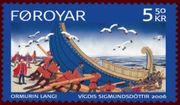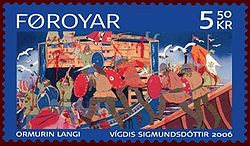
Ormurin Langi
Encyclopedia

Faroe Islands
The Faroe Islands are an island group situated between the Norwegian Sea and the North Atlantic Ocean, approximately halfway between Scotland and Iceland. The Faroe Islands are a self-governing territory within the Kingdom of Denmark, along with Denmark proper and Greenland...
. It was written ca. 1830 by Jens Christian Djurhuus
Jens Christian Djurhuus
Jens Christian Djurhuus or Sjóvarbóndin was the first poet who wrote in Faroese. He composed several Faroese ballads in traditional style on historical themes. The best known is Ormurin langi...
.
The song has 86 verses and is in Faeroese, and deals with the Norwegian king Olaf Tryggvason. The title Ormurin Langi refers to Olaf Tryggvason's ship with the same name (Ormrinn Langi in Old Norse).
History
Around 1800 there was an increasing amount of attention paid to the store of Faroese folk ballads (kvæði), which survived in the oral tradition and were sung as an accompaniment to Faroese dancing. Even before 1800 Jens Christian SvaboJens Christian Svabo
Jens Christian Svabo was a pioneering Faroese linguist, scholar, and ethnographer. Svabo was born in Miðvágur, Vágar, the Faroe Islands to a minister and his wife. Svabo studied history, music, and theology in Miðvágur and later in Tórshavn. Between 1765 and 1800 he lived in Denmark and studied...
had recorded ballads, but collecting got under way seriously after 1800, and names like Johan Henrik Schrøter, Jóannes í Króki and later on, V. U. Hammershaimb can be mentioned in this regard.
The old ballads were seen as having special historical value, but there was also interest in more recent ballads, e.g. comic ballads (táttur), and new ballads were composed in the old style. One poet who attracts particular notice is Jens Christian Djurhuus
Jens Christian Djurhuus
Jens Christian Djurhuus or Sjóvarbóndin was the first poet who wrote in Faroese. He composed several Faroese ballads in traditional style on historical themes. The best known is Ormurin langi...
(1773–1853), who was a farmer in Kollafjørður
Kollafjørður
Kollafjørður is a village in the Faroe Islands located on the island of Streymoy at 62°7′6″N, 6°54′20″W with a population of 822. Its postal code is FO 410. It is part of the Tórshavnar municipality.-See also:* List of towns in the Faroe Islands...
. The most famous of his works is Ormurin Langi, "The Ballad of the Long Serpent". His most individual work, however, is perhaps Púkaljómur (‘The Devils Ballad’), a religious epic based on a Danish translation of ‘Paradise Lost’ by the 17th-century English poet John Milton
John Milton
John Milton was an English poet, polemicist, a scholarly man of letters, and a civil servant for the Commonwealth of England under Oliver Cromwell...
.
Otherwise he mainly takes the subject matter for his ballads from the Norse sagas, e.g. ‘Heimskringla
Heimskringla
Heimskringla is the best known of the Old Norse kings' sagas. It was written in Old Norse in Iceland by the poet and historian Snorri Sturluson ca. 1230...
’ (‘The Chronicle of the Kings of Norway’) and ‘Færeyinga Saga
Færeyinga Saga
The Færeyinga Saga , the Norse saga of Faroemen, is the story of how the Faroes were converted to Christianity and became a part of the Kingdom of Norway.-Summary:It was written in Iceland shortly after 1200...
’, the story of how the Faroes were converted to Christianity under Sigmundur Brestisson
Sigmundur Brestisson
Sigmundur Brestisson introduced Christianity to the Faroe Islands in 999. He is one of the main characters of the Færeyinga saga.According to the Færeyinga Saga, emigrants who left Norway to escape the tyranny of Harald I of Norway, settled in the islands about the beginning of the 9th century...
and with the resistance of Tróndur í Gøtu
Tróndur í Gøtu
Tróndur í Gøtu was a viking from the Faroe Islands . He and Sigmundur Brestisson are the central figures in the Færeyinga Saga, which tells the early history of the Faroe Islands and the coming of Christianity to the islands, which Tróndur opposed.Chapter 3 of the Saga describes Tróndur as...
. This was the Romantic Age, and Norse literature was very much in vogue. Everything indicates that the Faroese immediately took his poetry to their hearts. In an account of a journey written in 1847-48 the ballad collector and clergyman V. U. Hammershaimb writes:
- "The old farmer Jens Christian Djurhuus of Kollafjørður has composed many ballads based on the sagas. They have been very successful and are sung everywhere with pleasure, since their language is pure and they are very much in keeping with the old style; his ballad about Olaf Tryggvason or the battle at Svolder, the ballads about Sigmund and Leif, and his version of Milton's Paradise Lost with its unusual metrical structure are particularly worthy of note."
Description

Heimskringla
Heimskringla is the best known of the Old Norse kings' sagas. It was written in Old Norse in Iceland by the poet and historian Snorri Sturluson ca. 1230...
of the famous sea battle off the island of Svolder
Battle of Svolder
The Battle of Svolder was a naval battle fought in September 999 or 1000 in the western Baltic Sea between King Olaf Tryggvason of Norway and an alliance of his enemies...
in 1000, when the Swedish and Danish kings, together with the Norwegian Eiríkr Hákonarson
Eiríkr Hákonarson
Eiríkr Hákonarson or Eric of Norway or Eric of Hlathir was earl of Lade, ruler of Norway and earl of Northumbria.-Background:...
, attacked the Norwegian king, Olaf Tryggvason, while he was on his way home from Wendland to Norway on his ship, the Long Serpent, accompanied by his fleet.
They attack in turn and King Olaf repulses the assaults of the two kings, but is defeated by his countryman Eiríkr Hákonarson.
The outcome of the battle is known; when Olaf realises that the battle is lost, he leaps overboard together with his surviving men.
It is not known where this battle took place, with it being doubtful whether there ever was an island called Svolder.
In the ballad the poet has Olaf sailing from the Baltic into the Oresund
Oresund
The Sound , is the strait that separates the Danish island Zealand from the southern Swedish province of Scania. Its width is just at the narrowest point between Helsingør, Denmark, and Helsingborg, Sweden...
between Denmark and Sweden, where he imagines the island to be located, and the battle takes place in the straits between the island and the mainland.
Stamps
Various scenes from the drama described in the ballad appear on ten stamps, issued in 2006 by Postverk FøroyaPostverk Føroya
Posta is the postal service of the Faroe Islands and was founded on 1 April 1976 under the Home Rule of the Faroe Islands. On 16 December 2005, it became a public joint stock company under the name P/F Postverk Føroya ....
and designed by the artist Vigdis Sigmundsdóttir
Vigdis Sigmundsdóttir
Vigdis Sigmundsdóttir is an artist from the Faroe Islands, most famous internationally for producing a collage of 12 motives from Ormurin Langi that resulted in a series of stamps from Postverk Føroya released in 2006.- History :Vigdis is a born artist, and started already as a child to draw,...
. They show shipbuilding and a launch, with the king sitting on the throne while giving an audience to Einarr Thambarskelfir. Another one shows the fleet putting out to sea. Another shows the Long Serpent and the other ships heading into the straits while their adversaries stand on the shore watching them. In the Long Serpent's bow there is Ulf the Red, Olaf's forecastle man, while the king and Einar the Archer are seen up on the quarterdeck. There are dead bodies tumbling into the sea during the battle, which ends with Eiríkr Hákonarson capturing the Long Serpent and so taking command of the vessel.
The location where the song is composed is unknown.
Versions and history
The oldest version dates back to 1819 and was made by Jóannes í Króki of Sandur. He also collected a version in 1823.When Svend Grundtvig
Svend Grundtvig
Svend Hersleb Grundtvig was a Danish literary historian and ethnographer. He was one of the first systematic collectors of Danish traditional music, and he was especially interested in Danish folk songs. He began the large project of editing Danish ballads. He also co-edited Icelandic ballads. He...
and Jørgen Bloch edited Føroya kvæði, an anthology of Faroese folksongs, around 1880, they knew of six recordings of the ballad.
A version in the poet's own hand turned up at a later date, but it is not known when it dates from.
Nowadays the ballad is referred to as Ormurin Langi (i.e. The Long Serpent), but that was not the title used by the poet himself.
He referred to it as Olaf Trygvasons kvad (‘'The Ballad of Olaf Trygvason’'), and other recorders did that as well, including Jóannes í Króki.
It was not until a version from around 1846 that it was discovered that the song got its title from Olaf Trygvason's ship, (Ormurin langi).
When Hammershaimb had the ballad printed in his principal work, Færøsk Anthologi (A Faroese Anthology) of 1891, he used the title Ormurin langi, and the same title was used when it was serialised a few years earlier (1882) in the Dimmalætting
Dimmalætting
Dimmalætting is the oldest and largest newspaper of the Faroe Islands and is based in Tórshavn.The first edition of the Dimma, as it is commonly known, appeared on January 5, 1878. Today it has a print run of 8,500 copies and appears five days weekly...
newspaper.
The lyrics of the ballad vary slightly from version to version, but when the ballad is performed today, it is always in the form known from ‘'Færøsk Anthologi.
Nor do the old versions agree on which refrain (and therefore which tune) to use. The refrain that reigns supreme today is found in only one of the oldest versions. It is the one used in Færøsk Anthologi and is, incidentally, familiar from some of the old ballads. Færøsk Anthologi has had a standardising effect and its text has in some ways become the authorised version.
External links
- Ormurin Langi (original text in Faroese from Föroysk kvæði by Jóannes Patursson, 1925)
- Ormen Lange (Norwegian translation by Per Sivle 1857-1904)
- Stamps.fo (Public Domain source)
- Tjatsi.fo (theme site by Postverk Føroya)
- Ormurin langi (original text in Faroese)

